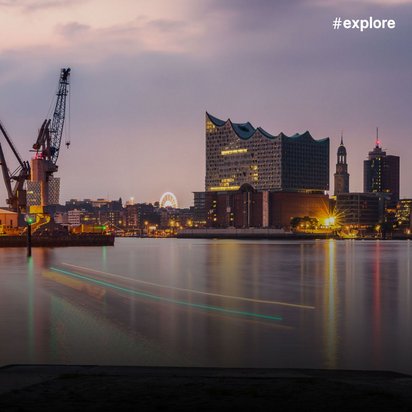Aim high!
Elevator inspection in the Elbphilharmonie
31 elevators transport guests at the Elbphilharmonie. Kay Thom Suden has inspected them all. In the #explore interview, he talks about the fascinating technology.

Aim high!
31 elevators transport guests at the Elbphilharmonie. Kay Thom Suden has inspected them all. In the #explore interview, he talks about the fascinating technology.

13 January 2017
A new landmark was inaugurated in Hamburg with the opening ceremony on January 11 and 12: the Elbphilharmonie. The striking building at the harbor is primarily a concert hall, complemented by a five-star hotel, restaurants, and upscale residential units. All of these are connected by numerous elevators – and each one was inspected by Kay Thom Suden from TÜV NORD. In the #explore interview, he explains the inspection process and shares what excites him most about the architecture.
This week, the Elbphilharmonie was officially opened. Since when have you been involved in the project?
The first inquiries came in 2007. At that time, the architects were working on different possibilities for designing the elevator systems. We evaluated these proposals to see if they could be implemented as planned. Most of the time, though, we had to say: No. (laughs)
Starting in mid-2009, I was regularly on-site for inspections—first for temporary construction elevators, and later for the many other systems. Sometimes I wouldn't be on the construction site for a quarter of a year, and then I’d be there for three weeks straight, depending on the stage of construction.
Are there really that many elevators there?
A total of 31. These include not only standard passenger elevators but also special ones like fire service elevators, which are designed to quickly transport firefighters to upper floors in emergencies. There are also large freight elevators and small "soup lifts"—freight elevators for the kitchens.
Was this just a job like any other for you?
No, this was truly fascinating, and I'm glad I had the chance to be part of it. Being involved in a project for ten years is unique. I was excited about the Elbphilharmonie from the very beginning, and during the construction phase, I was able to witness firsthand the techniques used to create a structure that is both lightweight and stable. Technically, it was also very interesting—there are different types of systems with very high speeds up to 3.5 m/s, lifting heights up to 90 meters, and load capacities up to 4 tons. Additionally, the elevators had to be continuously updated to reflect the latest technological standards.
"There are various systems there with very high speeds of up to 3.5 m/s, lifting heights of up to 90 meters, and load capacities of up to 4 tons."
Kay thom Suden, TÜV NORD
Why is that?
At the beginning of the construction period, elevators were still commissioned according to national regulations. Later, European standards and annexes had to be taken into account, and the Operational Safety Ordinance was also revised twice. For the manufacturer, this meant: everything had to be retrofitted, because the client demanded the latest state of the art. And that meant: a new inspection.
And have you been there since the Elbphilharmonie opened to the public at the end of last year?
Not yet – I’m letting those who haven’t been there yet go first. But I already have tickets for a concert and I’m looking forward to visiting the Elbphilharmonie as a ‘regular’ guest.
This is an article from #explore. #explore is a digital journey of discovery into a world that is rapidly changing. Increasing connectivity, innovative technologies, and all-encompassing digitalization are creating new things and turning the familiar upside down. However, this also brings dangers and risks: #explore shows a safe path through the connected world.